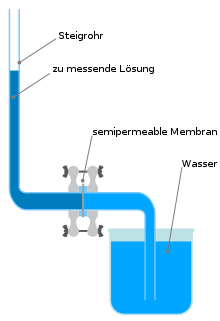Membrane osmometer

A membrane osmometer is a device used to indirectly measure the number average molecular weight () of a polymer sample. One chamber contains pure solvent and the other chamber contains a solution in which the solute is a polymer with an unknown . The osmotic pressure of the solvent across the semipermeable membrane is measured by the membrane osmometer.[1] This osmotic pressure measurement is used to calculate for the sample.
Basic operation
A low concentration solution is created by adding a small amount of polymer to a solvent. This solution is separated from pure solvent by a semipermeable membrane. Solute cannot cross the semipermeable membrane but the solvent is able to cross the membrane. Solvent flows across the membrane to dilute the solution. The pressure required to stop the flow across the membrane is called the osmotic pressure.[1] The osmotic pressure is measured and used to calculate .
In an ideally dilute solution, van ‘t Hoff’s law of osmotic pressure can be used to calculate from osmotic pressure.[1]
, number average molecular weight, mass/mole
, absolute temperature, typically Kelvin
, concentration of polymer, mass/volume
, osmotic pressure
Virial equations
In practice, the osmotic pressure produced by an ideally dilute solution would be too small to be accurately measured. For accurate measurements, solutions are not ideally dilute and a virial equation is used to account for deviations from ideal behavior and allow the calculation of . The virial equation takes a form similar to van ‘t Hoff’s law of osmotic pressure, but contains additional constants to account for non-ideal behavior:
where are constants and is still the concentration of polymer 1. This virial equation may be represented in different additional forms:
where and are constants and .
Different membrane osmometry devices
Static membrane osmometry
Capillary tubes are attached to both the solvent and the solution compartments. In this case the osmotic pressure is provided by the additional pressure of the fluid in the solution compartment. The difference in the height of the fluid in the capillary tube of solution compartment versus the height of the fluid in the capillary tube of the solvent compartment is measured once the solution reaches equilibrium to calculate the osmotic pressure.[1]
, osmotic pressure
, change in height
, density
, acceleration due to gravity
The main disadvantage of static osmometry is the long time it takes for equilibrium to be reached. It often takes 3 or more hours after the solute is added for the static osmometer to reach equilibrium.[2]
Dynamic membrane osmometry
In a dynamic osmometer flow of solvent is measured and a counteracting pressure is created to stop the flow. Flow rate of the solvent is measured by the movement of an air bubble in a capillary tube of the solvent.[2] The pressure of the solvent compartment is directly changed by raising or lowering a reservoir of solvent connected to the solvent compartment.[2] The pressure difference between the two compartments is the osmotic pressure. This can be calculate by measuring the change in height or measured directly with a flexible diaphragm.[2] Since the pressure is directly changed, an accurate measurement of osmotic pressure can be achieved in 10 - 30 minutes.[2]
Limitations of membrane osmometry
Membrane osmometry measurements are best used for 30,000 1,000,000 grams/mole. For above 1,000,000 grams/mole, the solute is too dilute to create a measurable osmotic pressure.[1] For below 30,000 grams per mole, the solute permeates through the membrane and the measurements are inaccurate.[2]
Another issue for membrane osmometer is the limited membrane types. The most common membrane used is cellulose acetate; however, cellulose acetate can only be used with toluene and water.[3] While toluene and water are useful solvent for many compounds, not all polymers are miscible in toluene or water. Regenerated cellulose membranes can be used for many other solvents, but are hard to obtain.[3]
References
- 1 2 3 4 5 Rudin, Alfred; Choi, Phillip (2013). The Elements of Polymer Science and Engineering (3rd ed.). Oxyford: Academic Press.
- 1 2 3 4 5 6 Chanda, Manas (2000). Advanced Polymer Chemistry. Dekker Marcel Inc.
- 1 2 Holding, S.R.; Meehan, E. (1995). Molecular Weight Characterization of Synthetic Polymers. Shrewsburry: RAPRA Technology Ltd.